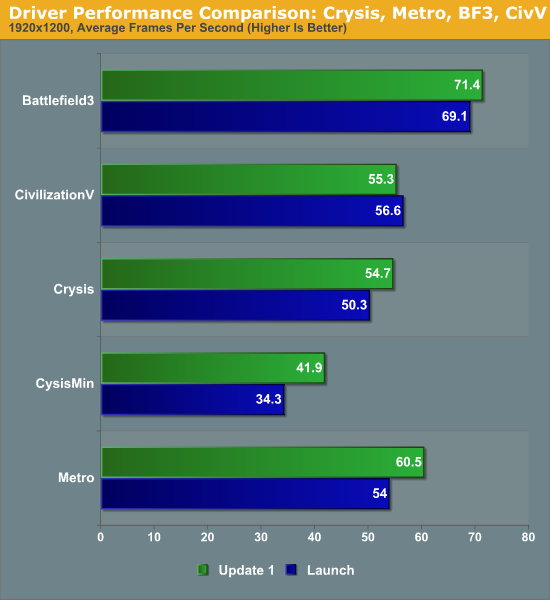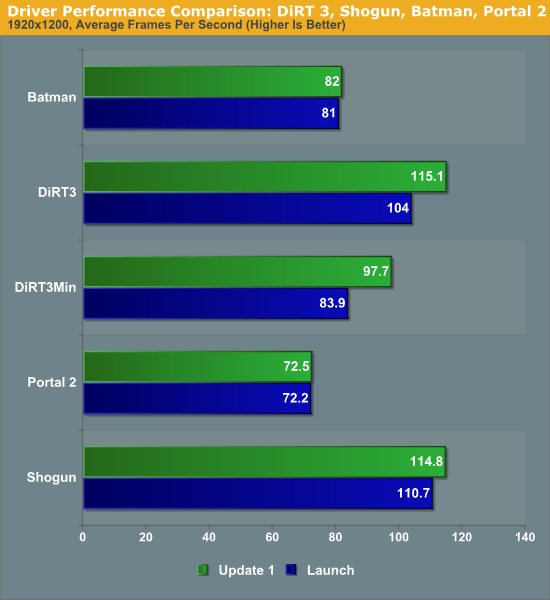AMD Radeon HD 7950 Review Feat. Sapphire & XFX: Sewing Up The High-End Market
by Ryan Smith on January 31, 2012 9:02 AM ESTGetting the Most Out of GCN: Driver Improvements
With the launch of any new architecture there’s still a lot of room for improvement on the part of driver developers, and GCN is no exception. On January 20th AMD released the first driver update for the 7000 Series, which brought with it an interesting mix of bug fixes, new features, and performance improvements. On the feature side AMD enabled support for Analytical Anti-Aliasing and Super Sample Anti-Aliasing for DX10+ games, an overdue feature that we’re very happy to see finally make it to AMD cards. Meanwhile on the performance side the new drivers improved the performance of the 7000 series in several games. Game performance typically rises slowly over time, but as this is one of the first post-launch driver releases, the gains are larger than what we’re used to seeing farther down the line.
To get an idea of where performance has improved and by how much, we reran our entire benchmark suite on the 7970.


As to be expected, at this point in time AMD is mostly focusing on improving performance on a game-by-game basis to deal with games that didn’t immediately adapt to the GCN architecture well, while the fact that they seem to be targeting common benchmarks first is likely intentional. Crysis: Warhead is the biggest winner here as minimum framerates in particular are greatly improved; we’re seeing a 22% improvement at 1920, while at 2560 there’s still an 11% improvement. Metro:2033 and DiRT 3 also picked up 10% or more in performance versus the release drivers, while Battlefield 3 has seen a much smaller 2%-3% improvement. Everything else in our suite is virtually unchanged, as it looks like AMD has not targeted any of those games at this time.
As one would expect, a result of these improvements the performance lead of the 7970 versus the GTX 580 has widened. The average lead for the 7970 is now 19% at 1920 and 26% at 2560, with the lead approaching 40% in games like Metro that specifically benefited from this update. At this point the only game the 7970 still seems to have trouble pulling well ahead of the GTX 580 is Battlefield 3, where the lead is only 8%.










259 Comments
View All Comments
mak360 - Tuesday, January 31, 2012 - link
i would easily buy the HD7950 over the old tech - outdated - hot - power hungry - loud GTX580 junk. The HD7950 is same price, new tech, uses 72 watts less, is cooler, is silent, is 28nm, is faster, has compute, has pcie3, has x3 monitors, has audio over each channel, also slaps the 590 if thats what you want lol.its a win-win, you would have to be an idiot to buy anything nvidia has currently in the high end.
chizow - Wednesday, February 1, 2012 - link
Anyone interested in high-end already owns Nvidia and is hitting the snooze button on this launch until Kepler.There's only a 15-25% reason to buy a 7970, 0-5% reason to buy a 7950.
Death666Angel - Wednesday, February 1, 2012 - link
You keep repeating it, and you keep being wrong. There are a million reasons for someone to upgrade their system now. Maybe they got a better monitor for christmas and need the graphics card upgrade but waited a month until AMD revealed their new tech? Maybe it's someones birthday and he can get a big card. Or someone got a new job and wants a new card today? Not everyone who has the money and need for such a card now had it in the months before it.chizow - Wednesday, February 1, 2012 - link
In that case, they should probably wait for the real next-gen, since that's what most anyone was doing prior to the disappointing Tahiti reveal.Or go ahead and pick up a 6970/570 for much better price/performance return. Although we may actually see the prices go back up now that its obvious Tahiti did nothing to force downward pricing pressure.
yankeeDDL - Wednesday, February 1, 2012 - link
Just look at the review from Tomshardware.Based on performance, they were expecting the 7950 to be prices around $480. Then they were informed about the MSRP of $450 and took it extremely well.
Just sayin'
Spunjji - Wednesday, February 1, 2012 - link
Unfortunately you gave yourself away as a bit of an idiot as soon as you failed to address anything about the product other than its raw performance.Precisely what makes you think that AMD /has/ to price their products at this level? They have a smaller chip that performs better for less power. As soon as nVidia releases competing products they'll drop trou on the price and everyone can be happy. Right now they're price-gouging the performance-obsessed, just like nVidia have been for as long as they've had the top product.
Personally, I'm disappointed that they've abandoned the 3/4/5000 series approach of providing fantastic value for money, but apparently that wasn't earning them any money. Big shame, don't care, move on. I'll be waiting for Kepler to show before I make any buying decisions.
chizow - Wednesday, February 1, 2012 - link
If the only thing AMD is able to bring to the table from a full node process shrink is a reduction in power consumption, they've already failed.What compounds their failure however, is the fact they're trying to price this card that doesn't even significantly outperform last-gen parts at existing prices.
If they actually priced this where it should be ~$380-$400, it'd be a completely different story. Because they'd actually be offering you all of those fringe benefits you listed as well as either high-end performance at a much lower price OR significantly higher performance at the same price.
These are the kinds of metrics people look at when deciding to upgrade, or not. Pricing a product that performs the same as a part that's been available for 14 months already just doesn't make any sense, sorry.
ven - Thursday, February 2, 2012 - link
after all the conversation you have given i came to only one conclusion you all guys created as much hype for the kepler. Nvidia will be much delighted for this.after reading all these I would be not surprised if Nvidia print a link to these website page on their kepler card boxes as part of their advertisement.chizow - Thursday, February 2, 2012 - link
I don't think Nvidia cares about what's written here tbh, I don't think it took more than looking at the benchmarks for them to get excited.What they care about:
-AMD's top 28nm = only 15-25% faster than their last-gen top 40nm
-AMD's 2nd 28nm = only 0-5% faster than their last-gen top 40nm
The result is the rumors and indirect quotes attributed to Nvidia personnel at CES amounting to:
"We expected more from AMD's HD7900 series."
But really, this quote could and should be attributed to anyone, especially at the asking price. It seems most people feel this way, makes you wonder why AMD fans don't.
Galidou - Saturday, February 4, 2012 - link
it's fun to see comparison of parts only by the size of the transistor..... the thing is the 40nm parts from nvidia from last gen are BIG gpus, you gotta compare the quantity of transistor to transistor to understand the % increase in performance....AMD's smaller gpus smaller power enveloppe that maxes performance/die size vs Nvidia's maximum die size/max performance attainable with good yields...